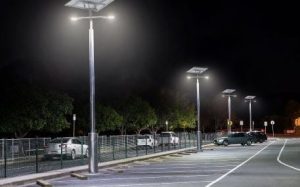Dispelling Myths that LED Lights are HarmfulPosted by Stephen Shickadance in Solar FAQs.
We're sure you've seen around the web some articles concerned with the technology behind LED lights and how they are (or can be) harmful. Technology can always be a scary thing, but it's important to understand why such information is circulating and how to get to the facts. In this day and age where fact-checking is imperative, Greenshine is giving you the facts with details. It may be the case you've read somewhere that LED lights are harmful to the eyes or terrible for the environment. That couldn't be further from the truth, and here's why: LED Lights are NOT Harmful: The Facts WhyRadiation Ain't a ThingMuch akin to a parent telling a child not to stick their face too close to a television (which is harmful), there may be a rumor that looking at an LED light is terrible for the eyes and emits too much radiation to be safe. The fact is LED lights emit no UV, infrared, or polluting radiation because of their super-low voltages. They contain no mercury or sodium that require special handling. That's particularly why Greenshine advocates the use of LED lights in the application of solar street lights. They're the "greenest" bulbs for use in any public lighting, and that's been the case for decades. LED lights are not harmful (as per law) and can be safely disposed of in landfills. We definitely aren't claiming LED lights are perfect (no bulb will ever be), but wouldn't you rather take the best you can get with what's available? That's specifically why Greenshine uses Cree LED light fixtures for all projects. Not only are you getting environmentally-friendly bulbs that are safe to use, but you're also getting the best brand available within that space. Waste is a Thing of the Past (Almost)Consider how often some bulbs or lamps need to be replaced. High-pressure sodium (HPS) bulbs need to be replaced every 24 thousand hours or so. That's less than half of the lifetime of standard LED bulbs, which means LEDs need less frequent disposal with their 50 thousand hours of operation time. Less waste equals a stronger environment. Plus, without high mercury or sodium levels, an LED bulb has a significantly smaller environmental footprint. Just toss the LED after 11 years--you can't quite do that properly with other light technologies though. Just another reason why LED lights are not harmful--even though some rumors may say otherwise. Do LEDs Emit Too Much Blue Light?Blue light tends to come up in conversations discussing whether or not LEDs are harmful for us. It's a fact that blue light stimulates what's called melanopsin, a hormone directly related to how "alert" we feel. That's typically why walking outside on a sunny day tends to wake people up--there's so much blue light that the hormone hits us heavy. That's the concern with using LED lights late at night. The blue light may cause melanopsin to activate, thereby keeping us more alert when we need the opposite. There are many factors to consider when it comes to blue light exposure and how it may impact our health, such as the light intensity, type of light, time of night the light is used, and how long you're exposed to it. We'll admit that using LED lights do emit some level of blue light, but it depends on how you're exposed. If you're under a solar LED light for only a few minutes, there won't be as much of an impact as if you're under several LED lamps while fixated on a screen. Rest assured that LED lights will have minimal effect on one's ability to sleep as long as the hours of exposure are managed. 30 minutes in blue light? You needn't worry. Three hours in blue light? You may see a drop in effective sleep, but there's not much to be concerned about. 10 hours in blue light exposure? We wonder how you spend your time. Flicker Bad?LEDs have a reputation for flickering. It's so fast that we aren't able to perceive it, but that kind of bulb behavior can be associated with headaches, eye strain, fatigue, and other health problems. However, if your lamps are flickering, it's a sign that you've purchased poor-quality LEDs. Cree LED light fixtures are established in the lighting realm as some of the highest-quality, most innovative lights on the market. Flickering is a sign that your purchase wasn't a wise one. It's commonly said that you get what you pay for. When it comes to lighting, don't go second best. Flickering happens, but not with quality. That's just another misconception that LED lights are harmful. The VerdictWe don't want false information circulating about lighting. It's an important aspect for businesses and municipalities to get quality lighting for wherever it's needed, but it's also important that you're well-informed about lighting in order to make the smartest decision possible when it comes to your project. At Greenshine, we know a thing or three about lighting and refuse to offer anything less than industry-standard lighting--it's our way of demonstrating that this myth that LED lights are harmful is far from the truth. But don't take our word for it--drop us a line and we'll tell you plenty more about how you can benefit from our lights if you're in the market to improve your business or city. Or, if you'd like to see a simulation of our lights, check our short video below!
Solar FAQs
|
ArchivesNo Archives Categories
Want More Info? |
LATEST NEWS & ARTICLES
